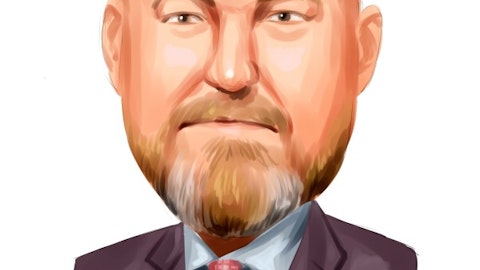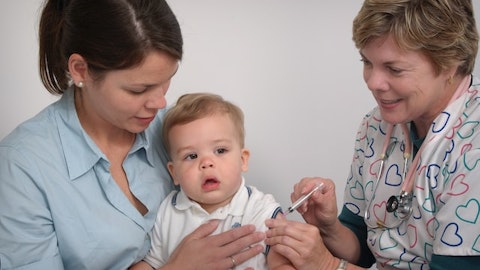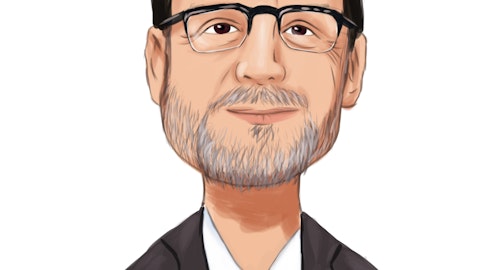Rick Wise: Yes, that’s good perspective. I’m going to ask one more this morning. I mean the cash flow question, obviously, it’s great to see the positive progress there. You’re in better at than I expected. You’ve said Fred, that you expect cash flow breakeven. My memory may be wrong, but I feel like you said cash flow breakeven within the next 5 years is why I remember you saying last. You want to update that? It seems like you’re making better progress more quickly. So is it within the next 4 years or 3 or 2? I’ll let you update it. Thank you.
Fred Hite: Yes, absolutely, Rick. Yes, you are right. Historically, we would have said in the next 5 years. We’re thinking now it’s probably closer to that 3-year mark as opposed to 5 years based on how we see things, the improvement in the adjusted EBITDA and the reduction in cash usage of the business. So versus 12 or 18 months ago, it’s probably a couple of years sooner than what we were thinking then.
Rick Wise: Excellent. Thank you.
Fred Hite: Thank, Rick.
David Bailey: Thanks, Rick.
Operator: Thank you. [Operator Instructions] It’s from the line of Ryan Zimmerman, with BTIG. Please proceed.
Ryan Zimmerman: Hey, thanks for taking the questions, guys. I wanted to just ask about kind of the state of the scoliosis market in the U.S. with some of the disruption and consolidation we’ve seen broader in spine. I am wondering if, Dave, you want to just – if you can speak to kind of what you are seeing from surgeons’ interest in ApiFix, especially in the context of maybe some of the other options either being hindered or less focus put on some of the specialized orthopedic products and what that may do for you guys from a user perspective as we think about 2024?
David Bailey: Yes. Thanks Ryan. Good question. So, you really like what we are seeing with ApiFix. In this quarter, we had extremely tough comp. I mean I think we had last year a surgeon that did six cases in a given day with ApiFix, and that was one of the surgeons that’s moved practice locations. So, it’s good to see it grow despite a really tough comp. But I mean we are getting a number of surgeons in historically, maybe a few years ago, who would have been sitting on the sidelines on the ApiFix front, moving towards IRB approval. And those IRB approvals are happening with more frequency, and we are getting through them faster, which is encouraging. So, I think that the likelihood that the way ApiFix develops over the course of the next several quarters is that all of our pediatric surgeons who take care of scoliosis are certainly well trained to place screws in the back of the spine, and I think feel very comfortable there.
And so this is an opportunity for literally every surgeon who uses scoliosis products who takes care of AIS to be trained on the ApiFix device and have that within their kind of armor material [ph] when they need to take care of patients with non-fusion patients with scoliosis. And I think that’s a little different than what we see with some of the other solutions. And I think we are going to continue to benefit by being able to have a lot more potential users globally. And maybe fewer sites that are doing 20, 30 a year, but most, every surgeon who takes care of pediatric spine really having ApiFix available to them. And I also think as we start to see better data and we had some nice data that came out of Germany here recently that I think is helping us to gain momentum, helping surgeons understand where to use ApiFix in their practice and what the likely result of that ApiFix procedures are going to be.
I think that’s driving interest in the product. And so while we have said that we don’t expect this necessarily to be a hockey stick. I do expect this thing to continue to get more and more traction. And obviously, the combination of ApiFix is pulling us into ORs that we weren’t in otherwise. So, when we say we added new fusion users in this quarter, a lot of that is because of their association with ApiFix or because of their association with 7D. So, really pleased to see it. Again, probably not a hockey stick in the next few quarters, but certainly up and to the right with ApiFix right now as the data gets better and we onboard more and more users.
Ryan Zimmerman: Got it. Okay. And then Pega sounds like going really well, was that constrained? You talked about maybe a little bit about kind of this opportunity over the coming months to get more sets out there for Pega. Just talk to us about kind of from a capacity standpoint or kind of where you are at in this development and kind of how you think about the broader or maybe longer term opportunity for that Pega business, now that it’s fully integrated and part of Operator?
David Bailey: So, we have been very successful in getting sets out to the field, particularly in the United States. We are now that the agency transitions that occurred outside of the United States. There is a great opportunity for us to start deploying inventory into some of our big agency markets, Germany, in particular, UK, some of these large markets. And Ryan, our expectation is that what we would see internationally in the next few years is what we have seen here in the United States over the last few years, where over the last five quarters, where almost instantly, you get an uptick in revenue because we have such strong representation. But then as you apply inventory and get products to the field that, frankly, a lot of these surgeons haven’t been exposed to in the past, you see increased share taking there and increased revenue.
So, really, really like kind of the trajectory of this now that we have got the international business integrated and expect to see really strong growth. Here in the United States, I think this continues to grow for us for the next several years. I mean what we are starting to see is some of the products that maybe were a little further down in the Pega portfolio. The SLIM-Nail, for example, is probably their number two product when we did the acquisition. That is becoming very rapidly adopted for a number of different procedures within the indication profile. And I think that is driving really substantial growth and we expect to see that continue for the next few years. So, in short, we expect this growth profile, while maybe it’s not going to double every year, we do expect this growth profile to be substantially higher than 20%, 25% year-over-year for the next few years.
And that’s one of the reasons why we have such confidence going into 2024.
Ryan Zimmerman: Got it. Very helpful. Thank you.
Operator: Thank you. One moment for our next question, please. It’s from the line of Samuel Brodovsky with Truist Securities. Please proceed.
Samuel Brodovsky: Hey. Thanks for taking my questions. The first one I will ask is just sort of what the implications for 4Q, and it’s a pretty wide range. Can you just give us some levers to what you think could drive it to the high end or the low end of the full year range in 4Q?
Fred Hite: Yes, absolutely, Sam. So, as Dave mentioned earlier, this December is our third largest month of the year, particularly in the scoliosis and the severe deformity correction, those big surgeries. And it’s always a wildcard, right. We never know exactly how it’s going to come in. So, that does explain some of the variance in the range depending on how December comes in. The other is RSV. As you recall, RSV was very prevalent last year at this time. It has taken an uptick from where it was in the summer. And so that’s always a wildcard on what that is going to do here in the next 60 days. So, those are two of the main reasons the range is so wide is really the environment more so than anything internal.
Samuel Brodovsky: Got it. And then just as we think about RSV, there was a bit of an uptick sort of towards the end of 3Q. Did that impact the quarter at all, or was that more typical levels of virus?



